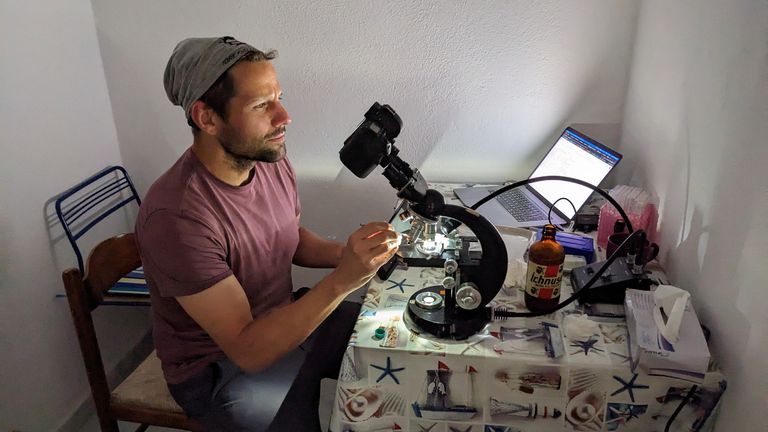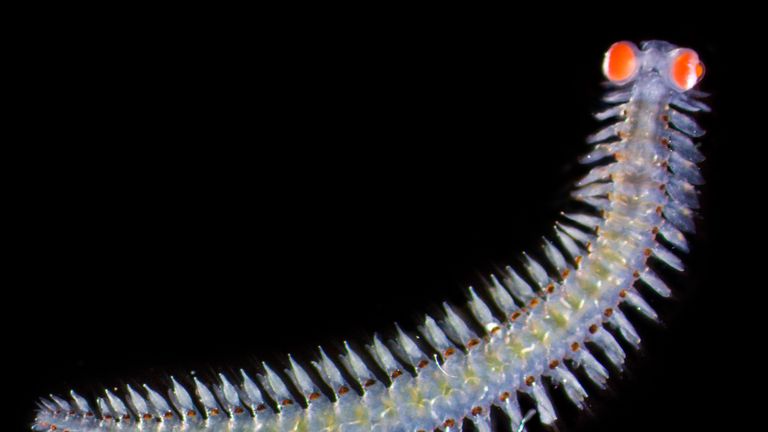Marine worm with ‘googly eyes’ 20 times heavier than its head may see in completely new way | Science & Tech News

A marine worm found off an Italian party island has grown enormous eyes that weigh about 20 times more than the rest of its head.
The eyes of the nocturnal Vanadis bristle worm are so large that if humans had eyes proportionally as big, they would add an extra 100kg to our heads.
Scientists have now discovered their massive eyes are very sensitive to ultraviolet (UV) light and could be used to secretly communicate with each other in the ocean darkness.
Their big eyes are also highly developed and work in the same way as human eyes. Outside of humans, no other vertebrates including insects, spiders, octopi and squid, have this kind of eyes.
“To be able to see in enough detail and at a high enough frame rate to be able to identify specific objects is actually kind of unusual,” said Michael Bok from Lund University, one of the marine biologists who investigated the worm’s unique eyes.
“Their eyes are strangely very sensitive to ultraviolet light,” added Mr Bok.
Pic: Michael Bok
Worms could communicate using light
The researchers suspect the bristle worms have evolved to see a new type of bioluminescence – a type of chemical light animals can produce.
“As far as we know, there’s no ultraviolet bioluminescence in nature. Everything is green or blue colours so this would be a completely new thing,” Mr Bok said.
As no other animal is known to use UV bioluminescence, the worms would be able to easily spot each other in the deep sea and communicate using their own type of light.
‘Very powerful behavioural driver’
The findings from Lund University, Copenhagen University and Tuscia University also prove how quickly eyes can evolve.
The closest relative to the Vanadis is almost completely blind and garden worms, who are in the same family as the bristle worm, don’t even have eyes – they have receptors that can tell them whether it is light or dark.
That suggests the bristle worm’s eyes have evolved very quickly, in evolutionary terms.
“These worms have massively expanded on their eye structure for something, so there’s got to be some very powerful behavioural driver for this to have happen,” said Mr Bok added.
After only ever coming across one of them, Mr Bok hadn’t even thought it was possible to study the worms in the wild. They are invisible in daylight so are hard to hunt.

Michael Bok in his temporary laboratory in Ponza. Pic: Michael Bok
“Randomly one day, I saw this video on YouTube of thousands of these worms swarming around some divers,” he said.
“That got me really excited. There was a place where we could actually go collect them.”

The worms were found in the Mediterranean near Ponza. Pic: Michael Bok
‘I freaked out when I saw them’
He contacted the divers in the video who had filmed the worms in the Mediterranean near Ponza, an Italian island known for its summer nightlife.
One of the divers, Armando Macali, a biologist from Tuscia University, offered to take Mr Bok and collaborator Anders Garm from Copenhagen University out to collect some worms.
“He said we would find them every day and we were a little bit sceptical. We’d never seen them in the wild before besides one individual [years before],” Mr Bok said.
“But, sure enough, when we jumped in the water the first night, there’s hundreds of them everywhere.”
Read more from Sky News:
Pandas’ diets may be sabotaging their sex lives
Schools won’t use Meta’s VR unless teachers have ‘complete visibility and control’
Tesla to cut around 15,000 jobs under Musk drive for ‘productivity’

Pic: Michael Bok
He added: “I freaked out at the first one I saw. I grabbed it in a plastic bag and frantically swam it back to the boat because I was so excited that we had one.
“Then I turned around and I saw them coming into the dive lights, and there [were] hundreds of them.”
The team went back each night and collected samples of the distinctive worm.
“I was pretty ecstatic and excited,” Mr Bok added.
“When you see these things, they’ve got these big, bulbous beach balls bouncing around on the side of their head as they’re swimming. So you know right away that definitely a [bristle worm], nothing else looks like that.”
Mr Bok and his colleagues are heading back to Ponza in two weeks to find out exactly how the worms use their “remarkable” eyes.







Recent Comments